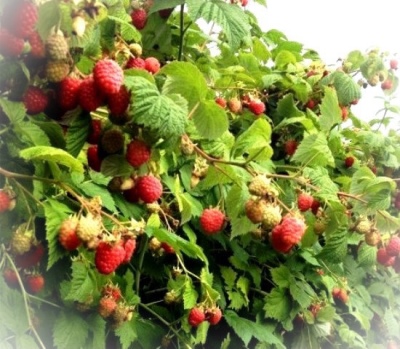
- Authors: Germany
- Repairability: No
- Berry color: red
- Taste: sweet and sour, pleasant
- Ripening period: average
- Berry weight, g: 2,2 -3,2
- Yield: 8-10 t / ha
- Frost resistance: medium
- Appointment: fresh consumption and for processing
- Fruiting period: last ripening in August
Raspberry Kaliningradskaya has a rich history, and it was bred in Germany. She came to our country after the war, when Königsberg was occupied by Soviet troops. The tasty berry began its triumphant march across the Soviet Union. Today this variety is in great demand among gardeners in our country.
Description of the variety
This variety is summer, recommended for planting in different regions, but taking into account the average winter hardiness. The shrub is quite powerful, with green shoots and waxy bloom, which acquire a red tone by the end of the season. There is no pubescence on the shoots, annuals with long internodes. Biennial plants are thick, brown in color, thorns are abundant, they are soft and located at the bottom. The foliage is large, ternary, with obvious wrinkles.
Among the advantages of the variety, the following are distinguished:
no additional pollination is required, the variety is self-fertile;
large berries;
high dessert quality and strong aroma;
strong shrubs, medium replacement of shoots, does not grow very actively.
There are also disadvantages:
low immunity, the variety is susceptible to pest attacks;
transporting the crop is problematic;
average winter hardiness;
there are thorns.
Ripening terms
This variety belongs to the average ripening period, the last harvest is in August. Climatic conditions can shift the maturation period.
Yield
The Kaliningrad variety is high-yielding, the average number of fruits per hectare is 8-10 tons. Raspberries can be used not only fresh, but also canned and frozen.
Berries and their taste
The berries of this variety are quite juicy, have a bright sweet taste with a slight hint of sourness, the structure of the fruit is fleshy. Strong aroma, typically raspberry. The weight of large-type fruits is on average more than 3 g. The shape is round, not sharp, slightly conical. The color is light, red, the drupes have thin skin, are not uniform, firmly pressed to the fruit bed.

Growing features
There is nothing too complicated in caring for the Kaliningrad variety; standard, but regular agricultural technology is required.
Moisturizing. It is necessary to water raspberries actively in the spring and in the summer, when the fruits ripen and develop. It is usually sufficient to moisturize the raspberries a couple of times a month, but generously. But it is better to refuse from frequent small watering. The procedures are completed in October, and after each watering, loosening of the soil is required. Do not forget to clear the soil of weeds, it is better to mulch the soil to simplify agricultural practices.
Fertilizers. Top dressing of this variety is best applied in the spring in the first year, especially of the organic type. Mullein or droppings are the best choice. In general, a couple of dressings per season are enough, and an adult plant, in general, can be fertilized only in autumn with mineral-organic compounds.
Garter.It is best to tie up raspberries, and choose a reliable support, since the bushes are very powerful. This can be done in a fan-like manner if the planting is bushy. It is optimal to tie the trench shrub with a trellis.
Preparing for winter. Since the resistance to frost is average, it is not in the southern regions that it is worth covering the plants with snow for the winter, for this they are bent to the ground.
Protection from pests and diseases. Since the immunity of the variety is low, it is necessary to carry out preventive measures against stem fly, raspberry beetle, spider mite.
Site selection and soil preparation
For this variety, it is necessary to choose an area with good lighting and no drafts. It is good to plant raspberries along the fence, buildings from the south. The slope is suitable for planting only in the middle zone, below the shrub can freeze or rot from the waters. Do not plant bushes after tomatoes, potatoes, strawberries and next to them. But an apple tree nearby will perfectly protect raspberries from gray rot.
In order for the variety to develop well, it is better to choose light-type soils with a good drainage layer. If the soil is sandy or peaty, it is worth spicing it up with compost, humus. Clay soil is not suitable for raspberries, as well as acidic. The earth is prepared in advance, for this it is dug up, fertilized with mineral, organic compounds. In the fall, the soil is prepared in about 30 days, and in the spring - from the fall.
Landing Algorithm:
the process must be completed before the beginning of the sap flow period, this is the end of March - the first half of April;
fertilizers are applied and mixed with the soil in a trench or hole;
water is poured in the amount of 2.5 liters per bush;
the roots need to be held a little in a chatter box made of clay and sent to the recess;
the root collar is deepened a couple of centimeters;
then you need to sprinkle loose soil, then it is tamped and moistened;
at the final stage, the soil is mulched.







Unfortunately, raspberries, like other plants, do not bypass various diseases and pests. Only armed with the knowledge and the necessary means for this, you can cope with such troubles.To help the plant, it is very important to be able to recognize the disease in time and begin timely treatment.
Reproduction
The easiest way to breed this raspberry variety is by summer cuttings. This method requires neither additional costs nor much time. The advantage of this method is that varietal characteristics are completely preserved. You can use green shoots for grafting, which are obtained during the summer thinning of the shrub.








































































